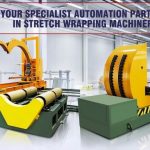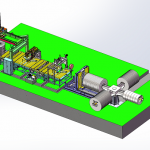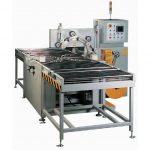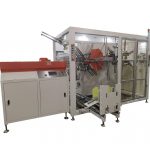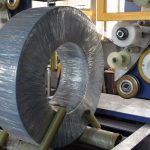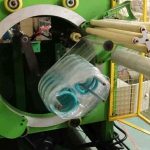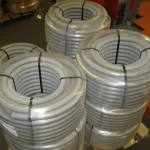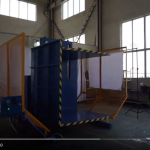What Is Slit Coil Packing Modernization?

Slit coil packing modernization involves upgrading existing systems to significantly enhance efficiency, accuracy, and safety within the packaging process. This modernization often includes the integration of advanced technologies such as automated conveyors, coil wrapping machines, and PLC (Programmable Logic Controller) controls. These technologies work together to automate previously manual tasks, streamline workflows, and boost overall productivity.
For instance, automated conveyors facilitate the seamless movement of coils through the packing line, reducing manual handling and the associated risks. Coil wrapping machines equipped with rotary rings and inverter controls ensure that protective materials are applied uniformly and with precise tension, adapting to various material types like paper and stretch film. PLC controls allow for centralized management of the packing line, offering adjustable settings for speed, tension, and material usage to match specific coil characteristics.
Modernization efforts can range from full system replacements to retrofitting individual components or adding intelligent control systems. These systems can communicate with upstream slitting lines and downstream storage and logistics, ensuring a cohesive and efficient operation across the entire production line. By implementing these updates, service centers can achieve higher levels of efficiency and safety, all while maintaining or enhancing the quality of packaging.
Ⅰ. Why Modernized Slit Coil Packing?
Modernizing slit coil packing lines is essential to meet today’s production demands, as traditional systems heavily depend on manual labor, leading to inconsistencies in packing quality, production slowdowns, and increased risks of workplace injuries. By upgrading to modernized systems, businesses can automate critical processes, which significantly reduces human error and enhances overall packaging consistency. These systems incorporate advanced technologies such as automated conveyors and PLC controls that streamline operations and ensure uniform application of protective materials, thus maintaining high packaging standards.
Moreover, modernized packing lines facilitate data integration and automation, allowing businesses to optimize operations and reduce labor costs. The integration of intelligent control systems enables seamless communication with upstream slitting lines and downstream logistics, further enhancing operational efficiency. This comprehensive approach not only improves safety by minimizing manual handling but also ensures the delivery of higher-quality products, meeting the expectations of an increasingly demanding market. As a result, businesses can expect to enhance their competitiveness by offering superior products while maintaining a cost-effective production process.

Ⅱ. Benefits of Slit Coil Packing Modernization
1.Increased Productivity:
Automation significantly reduces the dependence on manual labor, allowing for more coils to be packed in less time, thus enhancing throughput. Automated conveyors and wrapping machines streamline the entire process, ensuring a faster and more efficient operation.
2.Reduced Labor Costs:
By integrating automated systems, companies can lower their reliance on manual operations, decreasing costs associated with overtime and labor-intensive tasks. This shift not only reduces expenses but also reallocates human resources to more strategic roles.
3.Enhanced Packaging Precision:
Modernized systems ensure that each coil is consistently wrapped and strapped, providing better protection during transport. The use of PLC controls and adjustable tension settings ensures uniform application of protective materials.
4.Improved Safety:
Automation minimizes human interaction with heavy coils, significantly reducing the risk of workplace accidents. By using automated handling and stacking machines, the safety of the working environment is greatly enhanced.
5.Better Coil Protection:
Advanced wrapping and strapping technologies protect coils more effectively from damage during transit and storage. These systems offer precise control over tension and material application, ensuring optimal coil protection.
6.Real-Time Data Monitoring:
Integration with control systems like MES/ERP provides real-time updates on packaging performance and inventory levels. This connectivity allows for better decision-making and efficient resource management.
7.Scalability:
Modern systems are designed to be scalable, allowing facilities to expand their operations as production demands grow. This adaptability ensures that businesses can easily accommodate increased workloads without compromising efficiency.
Ⅲ. Types of Slit Coil Packing Modernization
1. Full System Upgrades:
This comprehensive approach involves upgrading all elements of the packing line, including PLC control systems for precise management, servo motors for enhanced motion control, and conveyor belts for efficient material handling. Such upgrades ensure that the entire system operates cohesively and efficiently.
2. Partial Modernization:
This strategy focuses on automating specific processes, such as adding automatic wrapping and strapping machines, to boost efficiency without a complete system overhaul. It allows companies to target inefficiencies while maintaining existing infrastructure, thus optimizing cost and effectiveness.
3. Retrofitting:
Retrofittinginvolves installing new, modern components into existing systems. This can include integrating advanced sensors for precision monitoring or hydraulic down-enders for improved coil handling, which enhances system capabilities without the need for a full replacement.
4. Software Integration:
Connecting the coil packing line to Manufacturing Execution Systems (MES) or Enterprise Resource Planning (ERP) systems allows for better data management and system synchronization. This integration facilitates real-time data exchange, improving decision-making and operational efficiency.
Ⅳ. Factors That Affect The Slit Coil Packing Modernization Cost
1. System Size and Complexity:
Larger and more complex systems naturally require more extensive upgrades, which can significantly increase costs. These systems often involve a greater number of components and integration points, making the modernization process more resource-intensive and time-consuming.
2. Level of Automation:
Implementing full automation, including sophisticated controls like PLCs and sensors, tends to elevate costs. The addition of automated conveyors, wrapping, and strapping machines demands a higher investment in advanced technology and installation expertise.
3. Technology Choices:
Selecting advanced technologies such as vacuum lifters, tension-controlled wrapping systems, and data integration tools can add substantial expense. These technologies enhance system capabilities but require a higher upfront investment for their procurement and integration.
4. Customization Requirements:
Custom programming and specific hardware modifications might be necessary to meet unique production needs, which can increase costs. Tailoring systems to fit exact operational requirements often involves bespoke engineering and software development.
5. Installation and Downtime:
The costs associated with installation and potential downtime during the upgrade process can significantly impact the total expense. Ensuring minimal disruption to operations while integrating new components is crucial but can be costly.
Ⅴ. Potential Cost Savings
1. Reduced Labor Costs:
Automated systems reduce the reliance on manual labor, which can decrease associated expenses by as much as 30-50%. The integration of automated conveyors and wrapping machines streamlines operations, allowing businesses to allocate human resources more effectively.
2. Lower Downtime:
Enhancing system efficiency and reducing equipment failure frequency minimizes production downtime. Modernized packing lines with reliable components, such as PLC controls and hydraulic systems, ensure smoother operations and less frequent interruptions.
3. Fewer Damaged Products:
Consistent packaging quality, achieved through modern systems, reduces the risk of product damage during transit. This decreases the number of returned or reworked items, contributing to cost savings and enhancing customer satisfaction.
4. Energy Efficiency:
Modern systems are designed for better energy efficiency, which cuts operational costs related to power consumption. Technologies like inverter-driven motors and energy-efficient conveyors help in achieving significant reductions in energy use.
Ⅵ . Slit Coil Packing Modernization Process
1. Assessment:
The process begins with a detailed audit of the existing packing system to identify areas that need improvement. This involves evaluating current equipment and processes to determine inefficiencies and potential upgrades.
Design & Planning: Collaborate with industry experts to design a modernization strategy tailored to the facility's specific requirements. This phase involves creating a detailed plan that outlines the necessary upgrades and how they will integrate with existing operations.
2. Equipment Selection:
Carefully choose the right combination of automated machinery, including coil wrapping and strapping machines, control systems like PLCs, and data integration tools to meet production needs. This selection is crucial to ensure compatibility and efficiency in the upgraded system.
3. Installation & Testing:
Install the selected equipment, followed by extensive testing to ensure all components work seamlessly together. This phase is critical to verify that the new systems operate as intended and meet the desired performance standards.
4. Training & Support:
Provide comprehensive training for operational staff on how to use the new systems efficiently. Ongoing technical support is essential to address any challenges and ensure smooth operation post-modernization.
Ⅶ . Considerations During The Slit Coil Packing Modernization Process
1. Minimizing Downtime:
Careful planning is essential to minimize downtime during the installation of new equipment. By scheduling installations strategically, businesses can ensure that production disruptions are kept to a minimum, thereby reducing the impact on overall operations.
2. System Compatibility:
Ensuring that new systems can integrate smoothly with existing equipment and upstream/downstream processes is vital for a successful modernization. This involves assessing the compatibility of new technologies with current systems to ensure seamless operation.
3. Staff Training:
Employees must be adequately trained to operate the new equipment, especially if it involves complex PLC or HMI interfaces. Comprehensive training programs are crucial to equip staff with the necessary skills to manage and maintain the modernized systems efficiently.
3. Future Scalability:
When selecting equipment, it's important to choose systems that can be easily expanded as production volumes grow. This foresight ensures that the facility can adapt to increasing demands without needing further extensive upgrades.
4. Maintenance & Support:
Establishing a plan for ongoing maintenance and technical support is essential to keep the modernized system running smoothly. Regular maintenance and access to technical assistance help prevent unexpected breakdowns and ensure continuous operation.
Ⅷ . Conclusion
Slit coil packing modernization is a powerful strategy for improving efficiency, reducing costs, and maintaining competitive advantage in today’s manufacturing environment. Whether it’s through full system upgrades or targeted enhancements, modernizing your coil packing line allows for higher productivity, better product protection, and lower operational costs. By investing in automation, data integration, and advanced control systems, businesses can position themselves for long-term success and scalability.
